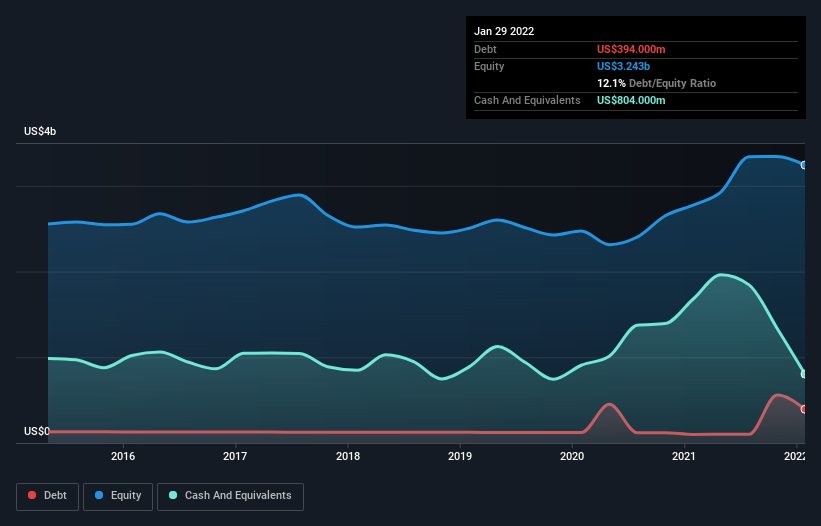- United States
- /
- Specialty Stores
- /
- NYSE:FL
These 4 Measures Indicate That Foot Locker (NYSE:FL) Is Using Debt Reasonably Well
David Iben put it well when he said, 'Volatility is not a risk we care about. What we care about is avoiding the permanent loss of capital.' So it might be obvious that you need to consider debt, when you think about how risky any given stock is, because too much debt can sink a company. We can see that Foot Locker, Inc. (NYSE:FL) does use debt in its business. But is this debt a concern to shareholders?
When Is Debt A Problem?
Generally speaking, debt only becomes a real problem when a company can't easily pay it off, either by raising capital or with its own cash flow. In the worst case scenario, a company can go bankrupt if it cannot pay its creditors. While that is not too common, we often do see indebted companies permanently diluting shareholders because lenders force them to raise capital at a distressed price. Having said that, the most common situation is where a company manages its debt reasonably well - and to its own advantage. When we think about a company's use of debt, we first look at cash and debt together.
Check out our latest analysis for Foot Locker
What Is Foot Locker's Debt?
You can click the graphic below for the historical numbers, but it shows that as of January 2022 Foot Locker had US$394.0m of debt, an increase on US$100.0m, over one year. However, its balance sheet shows it holds US$804.0m in cash, so it actually has US$410.0m net cash.

How Strong Is Foot Locker's Balance Sheet?
The latest balance sheet data shows that Foot Locker had liabilities of US$1.74b due within a year, and liabilities of US$3.16b falling due after that. Offsetting this, it had US$804.0m in cash and US$136.0m in receivables that were due within 12 months. So its liabilities total US$3.95b more than the combination of its cash and short-term receivables.
Given this deficit is actually higher than the company's market capitalization of US$2.79b, we think shareholders really should watch Foot Locker's debt levels, like a parent watching their child ride a bike for the first time. Hypothetically, extremely heavy dilution would be required if the company were forced to pay down its liabilities by raising capital at the current share price. Foot Locker boasts net cash, so it's fair to say it does not have a heavy debt load, even if it does have very significant liabilities, in total.
Even more impressive was the fact that Foot Locker grew its EBIT by 234% over twelve months. That boost will make it even easier to pay down debt going forward. When analysing debt levels, the balance sheet is the obvious place to start. But ultimately the future profitability of the business will decide if Foot Locker can strengthen its balance sheet over time. So if you're focused on the future you can check out this free report showing analyst profit forecasts.
Finally, a company can only pay off debt with cold hard cash, not accounting profits. Foot Locker may have net cash on the balance sheet, but it is still interesting to look at how well the business converts its earnings before interest and tax (EBIT) to free cash flow, because that will influence both its need for, and its capacity to manage debt. Over the last three years, Foot Locker recorded free cash flow worth a fulsome 92% of its EBIT, which is stronger than we'd usually expect. That puts it in a very strong position to pay down debt.
Summing up
While Foot Locker does have more liabilities than liquid assets, it also has net cash of US$410.0m. And it impressed us with free cash flow of US$457m, being 92% of its EBIT. So we are not troubled with Foot Locker's debt use. When analysing debt levels, the balance sheet is the obvious place to start. However, not all investment risk resides within the balance sheet - far from it. Case in point: We've spotted 4 warning signs for Foot Locker you should be aware of, and 2 of them are potentially serious.
If, after all that, you're more interested in a fast growing company with a rock-solid balance sheet, then check out our list of net cash growth stocks without delay.
New: AI Stock Screener & Alerts
Our new AI Stock Screener scans the market every day to uncover opportunities.
• Dividend Powerhouses (3%+ Yield)
• Undervalued Small Caps with Insider Buying
• High growth Tech and AI Companies
Or build your own from over 50 metrics.
Have feedback on this article? Concerned about the content? Get in touch with us directly. Alternatively, email editorial-team (at) simplywallst.com.
This article by Simply Wall St is general in nature. We provide commentary based on historical data and analyst forecasts only using an unbiased methodology and our articles are not intended to be financial advice. It does not constitute a recommendation to buy or sell any stock, and does not take account of your objectives, or your financial situation. We aim to bring you long-term focused analysis driven by fundamental data. Note that our analysis may not factor in the latest price-sensitive company announcements or qualitative material. Simply Wall St has no position in any stocks mentioned.
About NYSE:FL
Foot Locker
Through its subsidiaries, operates as a footwear and apparel retailer in North America, Europe, the Middle East, Africa, Asia Pacific, and internationally.
Adequate balance sheet and fair value.
Similar Companies
Market Insights
Community Narratives



